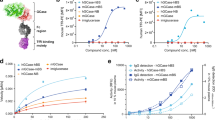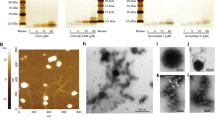Abstract
The brain vasculature forms an immense network such that most neural cells are in contact with a microvessel. Here we tested the hypothesis that endothelia lining these vessels can be harnessed to create a cellular reservoir of enzyme replacement therapy to diseased brain. As a model system, we used mice with central nervous system (CNS) deficits due to lysosomal storage disease (LSD mice). The basic premise of this work is that recombinant enzyme expressed in, and secreted from, the vascular endothelia will be endocytosed by underlying neurons and glia, decreasing neuropathology. We screened a phage library in vivo by panning to identify peptides that bound the vascular endothelia in diseased and wild-type mice. Epitopes binding diseased brain were distinct from those panned from normal brain. Moreover, different epitopes were identified in two distinct LSD disease models, implying a unique vascular signature imparted by the disease state. Presentation of these epitopes on the capsid of adeno-associated virus (AAV) expanded the biodistribution of intravenously injected AAV from predominantly liver to include the CNS. Peripheral injection of the epitope-modified AAVs expressing the enzymes lacking in LSD mice reconstituted enzyme activity throughout the brain and improved disease phenotypes in two distinct disease models (pages 1123–1124).
This is a preview of subscription content, access via your institution
Access options
Subscribe to this journal
Receive 12 print issues and online access
$209.00 per year
only $17.42 per issue
Buy this article
- Purchase on Springer Link
- Instant access to full article PDF
Prices may be subject to local taxes which are calculated during checkout




Similar content being viewed by others
References
Work, L.M. et al. Vascular bed–targeted in vivo gene delivery using tropism-modified adeno-associated viruses. Mol. Ther. 13, 683–693 (2006).
Grifman, M. et al. Incorporation of tumor-targeting peptides into recombinant adeno-associated virus capsids. Mol. Ther. 3, 964–975 (2001).
Müller, O.J. et al. Random peptide libraries displayed on adeno-associated virus to select for targeted gene therapy vectors. Nat. Biotechnol. 21, 1040–1046 (2003).
Perabo, L. et al. Heparan sulfate proteoglycan binding properties of adeno-associated virus retargeting mutants and consequences for their in vivo tropism. J. Virol. 80, 7265–7269 (2006).
Vogler, C. et al. A novel model of murine mucopolysaccharidosis type VII due to an intracisternal a particle element transposition into the β-glucuronidase gene: clinical and pathologic findings. Pediatr. Res. 49, 342–348 (2001).
Sleat, D.E. et al. A mouse model of classical late-infantile neuronal ceroid lipofuscinosis based on targeted disruption of the CLN2 gene results in a loss of tripeptidyl-peptidase I activity and progressive neurodegeneration. J. Neurosci. 24, 9117–9126 (2004).
Chang, M. et al. Intraventricular enzyme replacement improves disease phenotypes in a mouse model of late infantile neuronal ceroid lipofuscinosis. Mol. Ther. 16, 649–656 (2008).
Maheshri, N., Koerber, J.T., Kaspar, B.K. & Schaffer, D.V. Directed evolution of adeno-associated virus yields enhanced gene delivery vectors. Nat. Biotechnol. 24, 198–204 (2006).
Koerber, J.T., Maheshri, N., Kaspar, B.K. & Schaffer, D.V. Construction of diverse adeno-associated viral libraries for directed evolution of enhanced gene delivery vehicles. Nat. Protoc. 1, 701–706 (2006).
Grimm, D. et al. In vitro and in vivo gene therapy vector evolution via multispecies interbreeding and retargeting of adeno-associated viruses. J. Virol. 82, 5887–5911 (2008).
Liu, G., Martins, I., Wemmie, J., Chiorini, J. & Davidson, B. Functional correction of CNS phenotypes in a lysosomal storage disease model using adeno-associated virus type 4 vectors. J. Neurosci. 25, 9321–9327 (2005).
Song, L. & Pachter, J.S. Culture of murine brain microvascular endothelial cells that maintain expression and cytoskeletal association of tight junction–associated proteins. In Vitro Cell. Dev. Biol. Anim. 39, 313–320 (2003).
Acknowledgements
We thank G. Liu and J. Wilson for technical assistance and the Central Microscopy Research Facility at the University of Iowa. We thank C. Stein and P. Staber for reading of the manuscript. We thank W. Sly, St. Louis University, for goat antibody to β-glucuronidase. This work was supported by the US National Institutes of Health (grants HD33531, NS34568 and DK54759), the Batten Disease Research and Support Association and the Roy J. Carver Trust.
Author information
Authors and Affiliations
Contributions
Y.H.C. designed and performed the experiments and edited the paper, M.C. performed experiments and edited the paper, and B.L.D. developed the study, designed experiments and wrote the paper.
Corresponding author
Supplementary information
Supplementary Text and Figures
Supplementary Figures 1–5, Supplementary Tables 1 & 2 and Supplementary Methods (PDF 1693 kb)
Rights and permissions
About this article
Cite this article
Chen, Y., Chang, M. & Davidson, B. Molecular signatures of disease brain endothelia provide new sites for CNS-directed enzyme therapy. Nat Med 15, 1215–1218 (2009). https://doi.org/10.1038/nm.2025
Received:
Accepted:
Published:
Issue Date:
DOI: https://doi.org/10.1038/nm.2025
This article is cited by
-
Adeno-associated virus vector as a platform for gene therapy delivery
Nature Reviews Drug Discovery (2019)
-
Systemic AAV vectors for widespread and targeted gene delivery in rodents
Nature Protocols (2019)
-
Recent progress and considerations for AAV gene therapies targeting the central nervous system
Journal of Neurodevelopmental Disorders (2018)
-
Modulation of blood-brain barrier function by a heteroduplex oligonucleotide in vivo
Scientific Reports (2018)
-
Emerging Technologies for Delivery of Biotherapeutics and Gene Therapy Across the Blood–Brain Barrier
BioDrugs (2018)



